|
The potential and value of the automated medication reconciliation is obvious to any healthcare provider that has used it. The ability to see in an instance every medication which a person has obtained from every pharmacy and from every healthcare provider increases patient safety and the quality of care immeasurably.
To support patient control over their healthcare and to protect the confidentiality of a patient’s healthcare information only the provider who is seeing a patient can access this information. Furthermore, any patient can “opt out” of allowing their medication information be retrieved by healthcare providers.
In that the only reason a patient could want to prevent their healthcare provider from seeing this information is that they are obtaining medications from multiple providers and do not want providers to know that, SETMA has established a policy that if any patient restricts our access to this information we will no longer provide them with healthcare. Obviously, every patient who refuses to let us see this information may not be obtaining medications fraudulently but the risk is to great for us to take.
Continuing with the Automated Medication Reconciliation Tutorial
The alert “Medication history provided may be incomplete” is a disclaimer from Surescripts. You now need to click on the button outlined in green, entitled “Reconciliation.” This disclaimer is to make sure the provider knows that while the new system is excellent, it still requires the provider’s attentiveness.
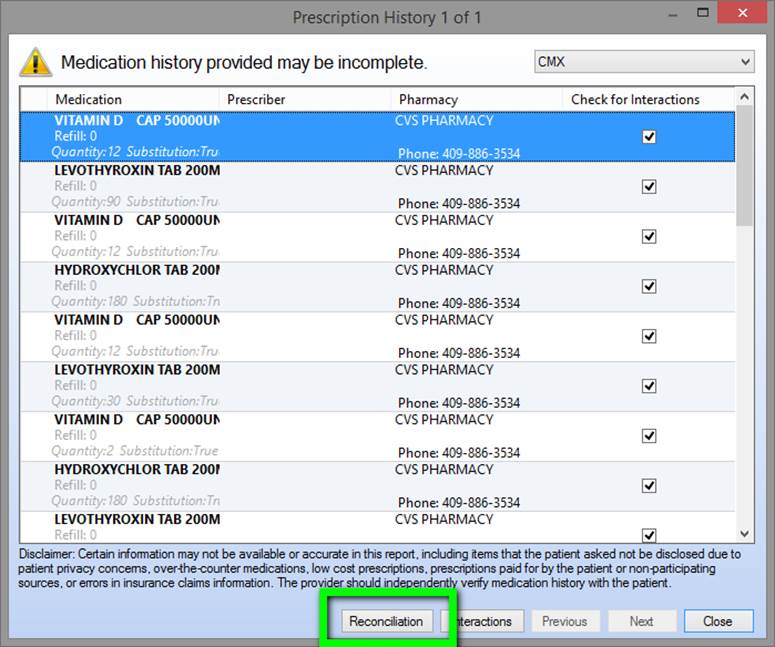
After you click the “reconciliation” button, the system will correlate the medications in the EMR record with the medications found from Surescripts. Those medications found in the EMR and in Surescripts Medication History will be tagged with a paperclip. There will be some medications which are not tagged. These may be duplicates or medications which have been discontinued or have been prescribed by another provider who is not in SETMA’s group.
One of the updates which SETMA has requested from Surescripts and NextGen is to collect at the bottom of the list all the medications not matched. This will make it easier to recognize which medications need the provider’s attention.

Several deficiencies presently exist which SETMA is working on with NextGen and Surescripts. One is that when the provider completes the “Medication Reconciliation” there is no foot print that the reconciliation has been done. This will be discussed later.
In the left hand screen below are the medications which appear in the EHR. The medications which are “tagged” are also found in the SureScripts Meducation history. Those which are not in the history are not tagged.
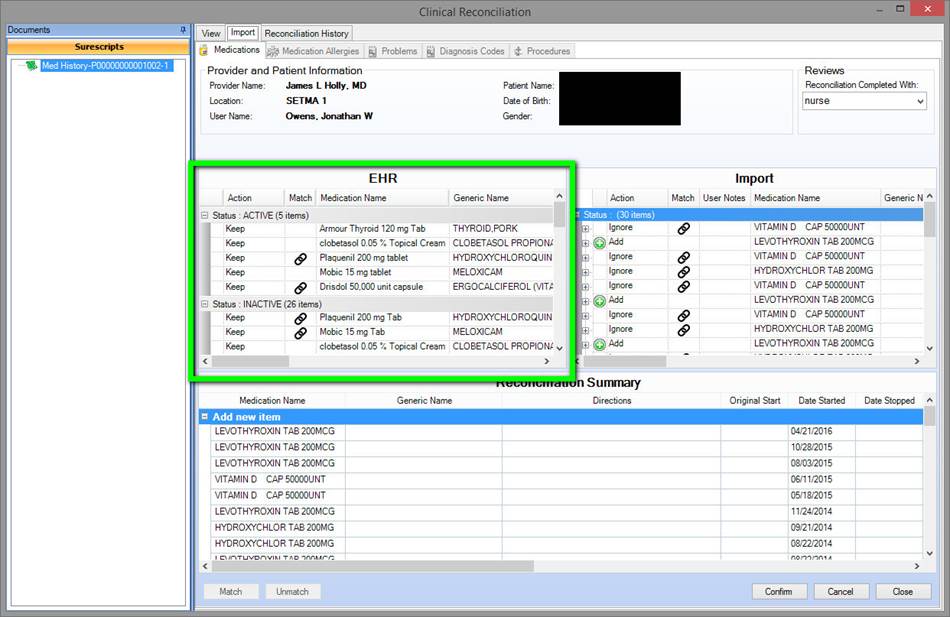
The medications in the right hand screen, outlined in green are from Surescripts.
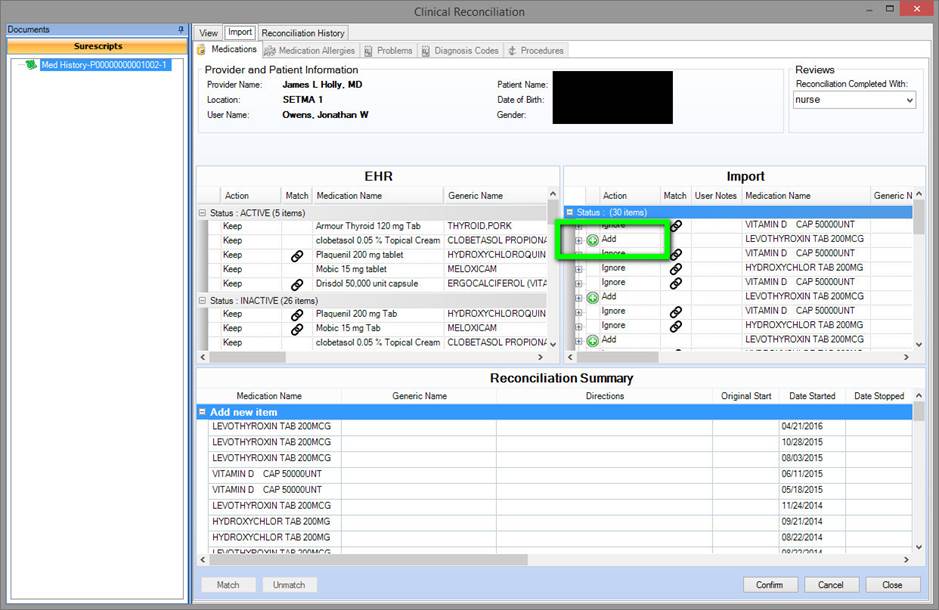
If the provider clicks “add” and if that medicine is a duplicate, the provider will be prompted with a note “Do you want to add a duplicate,” to which the provider would answer “no.” There are actually four “action” options: None Add, Ignore, Replace.
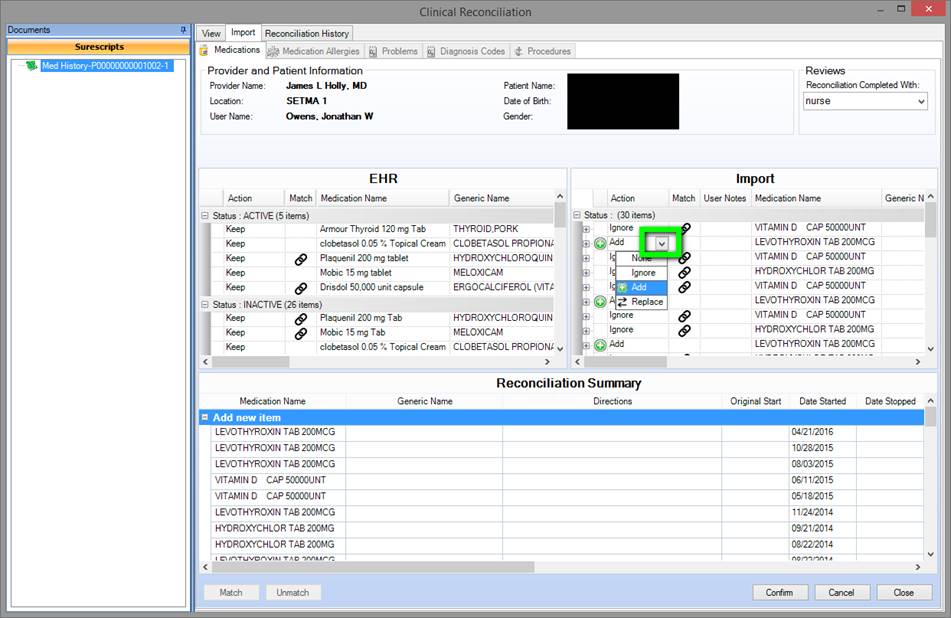
When the reconciliation process has been completed, the provider must click the button out lined in green below entitled, “confirm.”
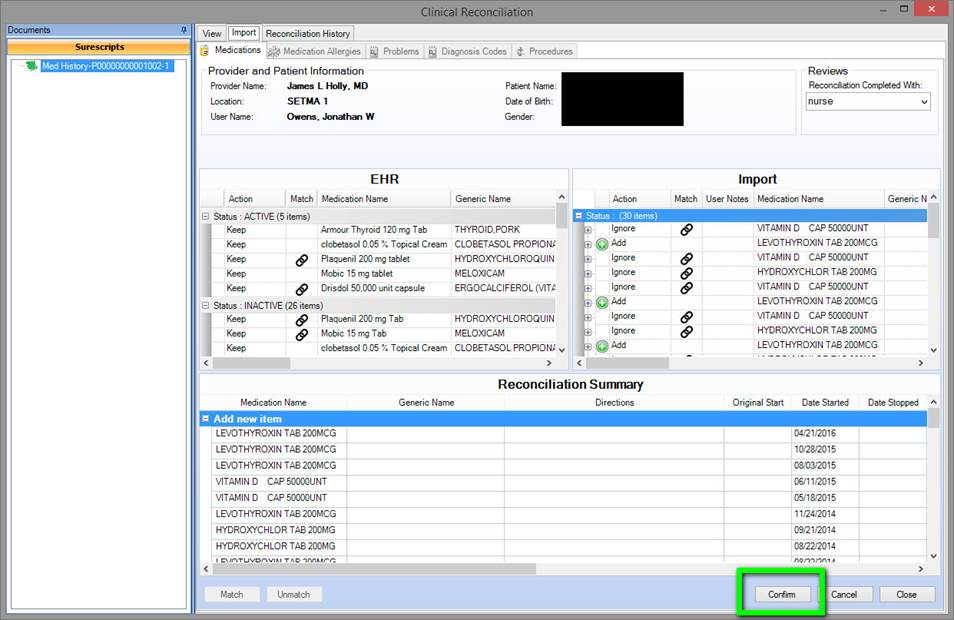
Addendum - Future Plans Being Discussed with Surescripts and NextGen
The following are functions which would make NEXTGEN's excellent medication reconciliation tool much better:
- In the window on the right where the medications appear which were pulled from SureScripts, it would speed the process up considerably if the medications which do not appear in the EMR could be listed together at the bottom of the list instead of mixed in with those which are matched
- It would be helpful if duplicates with identical names, dosages and sig codes could be electronically aggregated into a single display so that the provider would not have to respond to six or seven of the same medication, same dose, etc.
- When a list of medications have been reconciled that list should be marked as reconciled
- Once an initial reconciliation has been done future queries of Surescripts should only pull information since the last reconciliation, since the last visit, or since the time frame designated by the provider, i.e., 3 months 6 months, etc.
- When there are multiple lists of medications for reconciliation, when a medication is reconciled and it appears in another list it should be electronically marked as reconciled on all lists in which it appears.
Questions
- Medications which appear in the Surescripts list which also appear in the EMR list are marked. However, there are medications on the Surescripts which are not marked as being in the EMR, but when you click the button to update, there are alerts questioning whether you want to move a duplicate into the EMR. Why would those medications not already be marked during the reconciliation process?
- Sure Scripts apparently ties their query to insurance formularies which means the uninsured medications cannot benefit from this incredibly valuable tool. Why? There are other insurance companies such as Travelers Medicare, and many of the ACA Exchange companies which are not eligible for this function. Why?
- When a new patient comes to the practice and Surescripts is queried will their medications be found and then be able to be put in EMR. See below for the fact that Sure Scripts does not bring in the number of medications and the SIG code. That would be very important to enhance this tool.
If we can get a couple of easy updates from NextGen - the Medication Reconciliation Function will be awesome
Current Functions
- A display appears with the medications listed in the EMR in a left-sided screen
- A display of the medications which Surescripts shows the patient to be on in a right-sided screen
- Each medication in the right hand screen which is in Surescripts data, which also appears in the EMR records is tagged
- Each medication in the right hand screen which is in Surescripts data, but which is not in the ERM defaults to “add” but an option for “ignore” can be selected. When the medication is added to the medication module all data comes into the record including dosage, directions, etc.
- Once the two lists are reconciled, you update the record and it is done.
Here is the powerful part of this function:
- You don’t have to go through a bag of medication bottles
- If the patient doesn’t remember the medication or the directions, you have it.
- When you have a new patient, importing the patient’s medications from Sure Scripts is very easy.
- When a medication is imported the drug, dosage, date of filling, directions of use are all automatically included.
- When you use this tool it automatically notes that you have reconciled medications.
Limitations of NextGen’s Deployment:
- At present the reconciliation files only include 50 instances of medications or refills. If the patient has 500 incidents, you will have ten files to go through - unusual but possible. For instance, if the patient is on 12 medications and they are refilled every month, in a year you will have 144 incidents.
- Currently, there is no way to truncate the Surescripts reconciliation to only see the medications for the past 3, 6, 12, 18, 24 months.
- Once you have completed a reconciliation, there is no current function to note that the medications in that file have been reconciled, so the next time you reconcile the medications you will have to go back through all ten files of all 500 medications.
- In reality, once you have done a reconciliation, in the future, you would probably only want to reconcile the medications from the last time you saw the patient, whether that is six weeks, six months or six years.
With a little work from NextGen, we can get to a 90+% of what we want from Medication Reconciliation. In consultation with Surescripts, in a very short period of time, we can make this process very simply, very fast and excellent. The improvement in patient care quality and safety will be enormous
A third element of the complete medication reconciliation is the patient’s “bag of medications”
- We need a scanner in each exam room or in each pod so that then the patient brings in their “bag of medicine,” they can scan rather than transcribed into the EMR.
- If NextGen can design a solution where these scan medications can populate a third window in medication reconciliation with the names, dosages, sig codes and quantity of medications, it would allow us to reconcile EMR meds with Sure Script meds with the patient’s meds
SETMA’s Note: The Medication History and Medication Reconciliation is a wonderful tool.
Example from this morning: Saw an established patient today. He had not told my nurse that he saw another doctor yesterday and that he was started on a new medicine. I asked him what it was and while he was pulling out the prescription bottle, I clicked on Medication History.
Even though it was yesterday afternoon that he had the medicine filled, it was already in the list of filled prescriptions that popped up. Rather than having to put the medication into the EMR, I simply clicked on the Reconciliation button and selected “Add” medication. All details medicine, date of filling, number of medications and sig codes were added automatically.
|